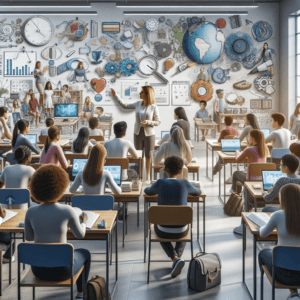Innovative Teaching Methods Transforming Education in the U.S.
The landscape of education in the United States is undergoing a significant transformation, driven by innovative teaching methods that enhance student engagement and learning outcomes. As educators seek to address the diverse needs of learners and adapt to a rapidly changing world, a variety of approaches have emerged, reshaping traditional classrooms into dynamic environments that foster creativity, critical thinking, and collaboration.
Project-Based Learning (PBL)
One of the most effective strategies gaining traction in American schools is Project-Based Learning (PBL). PBL encourages students to engage in hands-on projects that align with real-world problems. This method not only makes learning more relevant but also cultivates problem-solving skills and teamwork. For instance, students might work in groups to design solutions for local environmental issues or develop business plans for community projects. By immersing themselves in projects, learners acquire knowledge and skills while practicing critical 21st-century competencies.
Flipped Classrooms
The flipped classroom model is another innovative approach that has captured attention. In this model, students first explore new content outside of class, typically through video lectures or reading assignments. Classroom time is then dedicated to discussions, collaborative activities, or hands-on exercises that reinforce understanding. This technique allows for more personalized learning experiences and gives educators the opportunity to provide targeted support where necessary. The flipped classroom not only maximizes valuable instructional time but also transforms the role of the teacher from a lecturer to a facilitator of learning.
Technology Integration
Integrating technology into the classroom has revolutionized education. Tools such as interactive whiteboards, tablets, and learning management systems have become commonplace, fostering an engaging interactive environment. Virtual and augmented reality experiences allow students to explore concepts in immersive ways that were previously unimaginable. For example, students can take virtual field trips to historical sites or conduct science experiments in a simulated lab. This integration not only appeals to various learning styles but also prepares students for a technology-driven future.
Collaborative Learning
Collaborative learning strategies emphasize group work and peer interaction, facilitating a sense of community among students. Techniques such as cooperative learning, peer teaching, and study groups enable students to learn from one another, sharing diverse perspectives and skills. This method not only promotes social and emotional development but also encourages accountability and responsibility within teams. When students collaborate, they often engage in deeper discussions and develop a stronger understanding of the material.
Social-Emotional Learning (SEL)
The recognition of the importance of mental health and emotional well-being has given rise to Social-Emotional Learning (SEL) programs in schools across the U.S. SEL focuses on helping students develop skills to manage emotions, build healthy relationships, and make responsible decisions. Incorporating SEL into the curriculum fosters a supportive learning environment where students feel valued and understood. This approach leads to improved academic performance, reduced behavioral issues, and increased overall school satisfaction.
Inquiry-Based Learning
Inquiry-Based Learning invites students to ask questions, conduct research, and engage in hands-on experiments to seek answers. This student-centered approach encourages curiosity and a love for learning, allowing students to take charge of their educational journey. Educators act as guides, providing resources and support while encouraging students to explore concepts deeply. By nurturing inquiry, schools cultivate a generation of critical thinkers who are prepared to tackle complex challenges.
Conclusion
The innovative teaching methods transforming education in the U.S. reflect a shift towards student-centered approaches that prioritize engagement, collaboration, and real-world application of knowledge. As educators adopt these strategies, they are not only enhancing the learning experience but also preparing students for a future filled with opportunities and challenges. The commitment to evolving instructional practices holds the promise of a more inclusive, effective, and dynamic education system for all learners.







